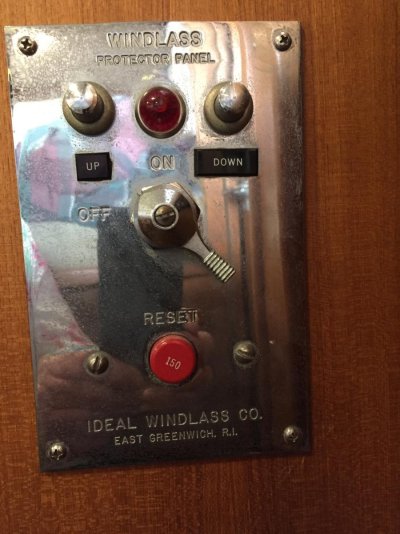AvalonGB
Veteran Member
Since we will be installing a 24v bow thruster I’m hoping to make two additional improvement to Avalon’s systems using the new 24v battery bank.
We’ve occasionally had the windlass draw down the 12v house system to a level low enough to cause our Furuno TZT MFD screens to shut down – a potentially very bad situation as can damage displays memory. Now this only happens when operating the windlass for extended run times, don’t have exact time, but needs to be addressed. The house bank is 750AH and in good condition. As the windlass uses significant power, Lofrans Tigres, leveraging the 24v bow thruster bank would isolate the system from the house and seems to be a good idea.
We also have the washdown pump located in the lazerette and don’t get the best water pressure, 50’+ run to the bow, so I’m going to install a Groco C-80 24v pump in the bow and utilize the 24v thruster bank. Should give us much improved performance.
The washdown pump install is straight forward and should be relatively easy to configure and install. The windlass conversion to 24v is looking like its going to be significantly more complicated. The photo I’ve attached shows the main breaker and lower helm control for the current windlass, breaks the 12v line from house bank and includes up and down controls.
My question / challenge I’m trying to figure out.
Appears that I need to convert the current 12v controls at both helms to 24v, making the upgrade to 24v windlass much more complicated than I originally envisioned. Anyone have any thoughts on the conversion or is it possible to leave the controls 12v with windlass being 24v. Also does not seem to make sense to run 24v line to breaker at lower helm as significantly increases wire run and voltage drop vs going from thruster bank directly up to windlass. Wondering if there is the possibility to operate a solenoid or switch for 24v line remotely from lower helm.
Any thoughts or suggestions on my project are much appreciated.
Thanks,
Tim
We’ve occasionally had the windlass draw down the 12v house system to a level low enough to cause our Furuno TZT MFD screens to shut down – a potentially very bad situation as can damage displays memory. Now this only happens when operating the windlass for extended run times, don’t have exact time, but needs to be addressed. The house bank is 750AH and in good condition. As the windlass uses significant power, Lofrans Tigres, leveraging the 24v bow thruster bank would isolate the system from the house and seems to be a good idea.
We also have the washdown pump located in the lazerette and don’t get the best water pressure, 50’+ run to the bow, so I’m going to install a Groco C-80 24v pump in the bow and utilize the 24v thruster bank. Should give us much improved performance.
The washdown pump install is straight forward and should be relatively easy to configure and install. The windlass conversion to 24v is looking like its going to be significantly more complicated. The photo I’ve attached shows the main breaker and lower helm control for the current windlass, breaks the 12v line from house bank and includes up and down controls.
My question / challenge I’m trying to figure out.
Appears that I need to convert the current 12v controls at both helms to 24v, making the upgrade to 24v windlass much more complicated than I originally envisioned. Anyone have any thoughts on the conversion or is it possible to leave the controls 12v with windlass being 24v. Also does not seem to make sense to run 24v line to breaker at lower helm as significantly increases wire run and voltage drop vs going from thruster bank directly up to windlass. Wondering if there is the possibility to operate a solenoid or switch for 24v line remotely from lower helm.
Any thoughts or suggestions on my project are much appreciated.
Thanks,
Tim

